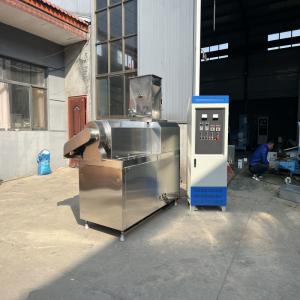
Add to Cart
500kg/H Stainless Steel Pet Feed Extruder/Pet Food Processing Machine
Product Description:
1. Using a single-screw extruder, suitable sinking extruded feed can be produced by controlling the material moisture, screw speed, machine temperature and other conditions.
2. Increasing moisture content is beneficial to starch gelatinization and improves the water stability of granules. However, materials with too high moisture content (above 29%) will have poor conveying performance in the extruder; materials with too low moisture content will easily produce floating feed and reduce the water stability of the particles.
3. The screw speed of the extruder has a great influence on the sinking material. The suitable screw speed is 150~190r/min. Too high a screw speed will produce floating feed, while too low a screw speed will reduce the gelatinization and water stability of the pellets.
4. The temperature control of the extruder barrel is also very important for the production of sinking extruded feed. When producing sinking materials, the curing area needs to be cooled, and the temperature should be controlled at 40~60C. If the temperature is too high, floating feed will be produced, and if the temperature is too low, the gelatinization degree and water stability of the particles will be reduced. The use of raw soybean flour in the formula raw materials is beneficial to improving the water stability of the particles, but the extent is limited.
| Model | Main Power | Cutter power | Cutting power | Capacity |
| EW-65 | 22kw | 0.75kw | 0.75kw | 200kg/h |
| EW-70 | 37kw | 1.1kw | 1.5kw | 300kg/h |
| EW-85 | 55kw | 1.5kw | 3kw | 500kg/h |
Working Principle:
The raw materials are evenly fed into the screw extrusion chamber from the feeder. The space volume of the extrusion chamber gradually becomes smaller along the direction of material advancement, and the expansion force on the material gradually increases. At the same time, the movement of materials in the extrusion cavity is accompanied by strong shearing, rubbing and friction. Sometimes, if necessary, an electric heating chip can be installed outside the puffing chamber to assist heating. As a result of this combined effect, the temperature of the material rises sharply, and the starch in the material is gelatinized. The entire material becomes a molten plastic colloid. At the moment when the material is discharged from the extrusion die hole, the pressure suddenly drops to 0.1Mpa, and the water quickly turns into steam to increase the volume, causing the material volume to expand rapidly. The water vapor further evaporates and escapes, reducing the moisture content of the material. At the same time, the temperature also dropped quickly. The material solidifies immediately, and many micropores appear in the coagulated colloidal material. The continuously extruded columnar or sheet-shaped puffed products are cut by a rotary cutter and then cooled. Sometimes, post-processing steps such as drying and spraying of additives (such as oils and vitamins, etc.) are required.
